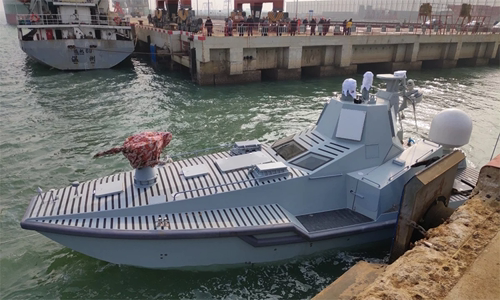The multi-purpose unmanned combat boat, called JARI, has been tested at sea, according to Chinese media.
JARI is China's first unmanned surface vehicle (USV), capable of carrying out a variety of missions such as anti-submarine, air defense and surface warfare. The first JARI prototype was launched in August 2019 and the photo of this USV sample was recently published in China's Far East Science and Technology magazine, but the time and place of the test was unknown, SCMP reported. January 17.

JARI multi-purpose battle boat on sea trials Photo: SCMP
JARI combat boat is 15 m long, weighs 20 tons, maximum speed over 77 km / h, is equipped with active array radar similar to the Type 052D missile destroyer, with a hydro-acoustic system can track items. pepper underwater in a distance of 7 km. The boat is armed with a 30 mm cannon, short-range air defense missile, two anti-aircraft missile launchers and anti-ship missiles and two anti-submarine torpedo tubes.
"The carrier or assault landing vessel can carry JARI to increase reconnaissance and ambush capabilities. Once the technology is complete, the canoes can launch a 'wolf pack' attack against the ship. water surface of a large enemy, "wrote Vien Dong Industry Science.
However, this magazine points out that JARI still faces many technological obstacles. China Shipbuilding Industry Group (CSIC) is currently facing difficulties with the rapid deployment and recovery of JARI, as well as ensuring the safety of navigation when operating the boat, especially in the adverse weather conditions at sea.
CSIC's 716 and 702 research institutes responsible for developing JARI first announced information about this USV in 2018. CSIC brought JARI to display at the International Defense Exhibition and Conference in the United Arab Emirates united in 2019.
Other countries are developing unmanned surface combat vehicles because they are low-cost, highly maneuverable, able to "stealth" before enemy reconnaissance weapons and perform tasks. danger.
The US Navy has deployed several USVs to detect torpedoes and detect enemy submarines. The United States is developing two large unmanned surface water vehicles (LUSVs) with dimensions comparable to destroyers and capable of performing various independent or coordinated missions with manned warships.



 ColleenAnoraConant
ColleenAnoraConant







